Cultural Reflections Journal for Working Across Cultures (MBA6150)
VerifiedAdded on 2022/09/18
|17
|4292
|20
Journal and Reflective Writing
AI Summary
This assignment is a reflective journal from a student enrolled in the 'Working Across Cultures' unit, MBA6150, providing a comprehensive exploration of intercultural communication. The journal is structured around weekly reflections, covering key topics such as cultural values, communication barriers, culture shock, and language in business contexts. The student analyzes personal experiences, identifies challenges, and proposes solutions, demonstrating an understanding of concepts like Hofstede's and Trompenaars' cultural dimensions, ethnocentrism, and the impact of cultural values on business practices. The journal also addresses practical scenarios, including case studies on negotiating contracts in different cultural settings, and offers insights into overcoming cultural barriers to achieve effective communication and collaboration in a globalized world. The student reflects on how to improve their skills and capabilities in a cross-cultural setting, including understanding different cultures and nationalities to perform together within an organization and comprehending each other for achieving success. References from various academic sources support the student's reflections and analysis.
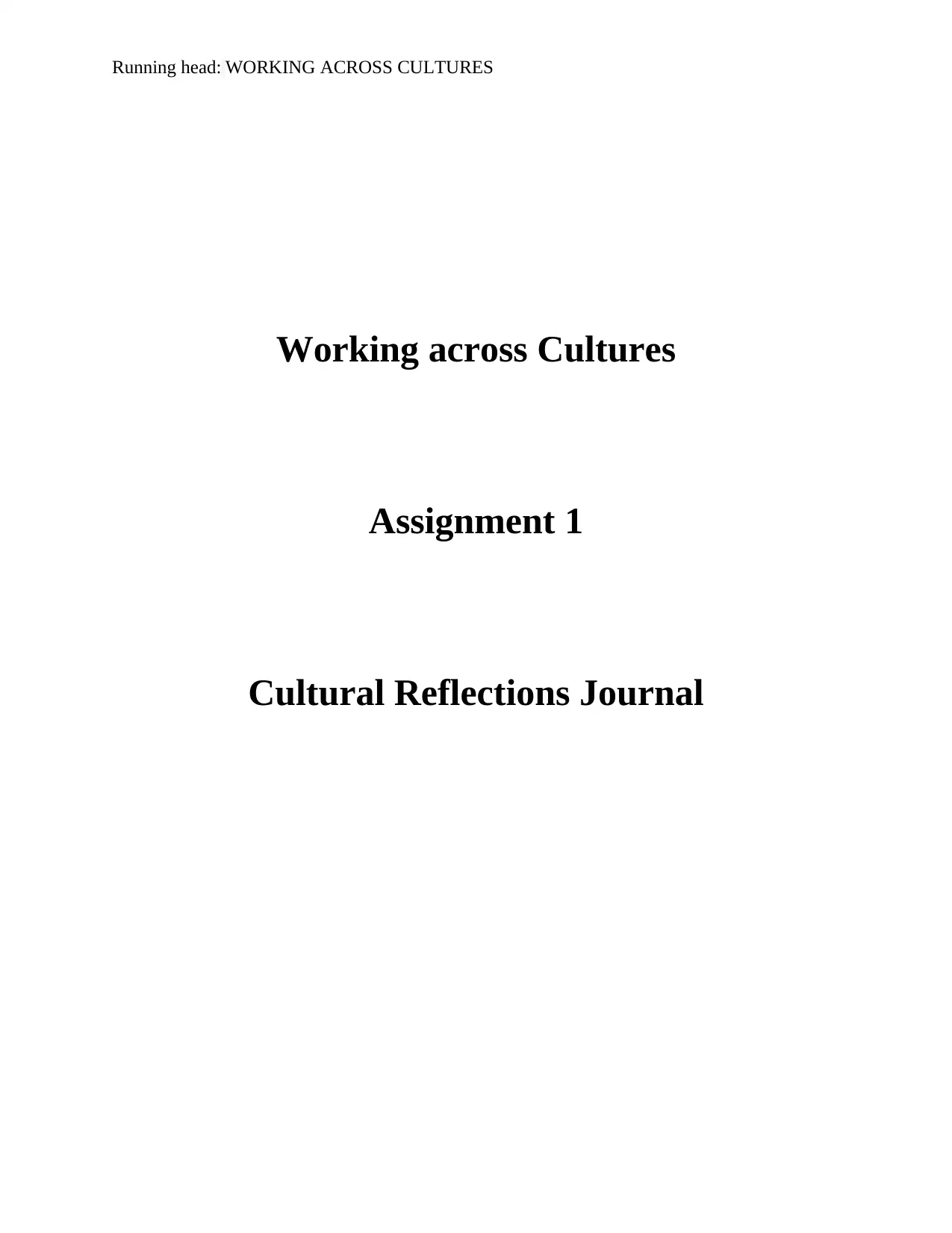
Running head: WORKING ACROSS CULTURES
Working across Cultures
Assignment 1
Cultural Reflections Journal
Working across Cultures
Assignment 1
Cultural Reflections Journal
Paraphrase This Document
Need a fresh take? Get an instant paraphrase of this document with our AI Paraphraser
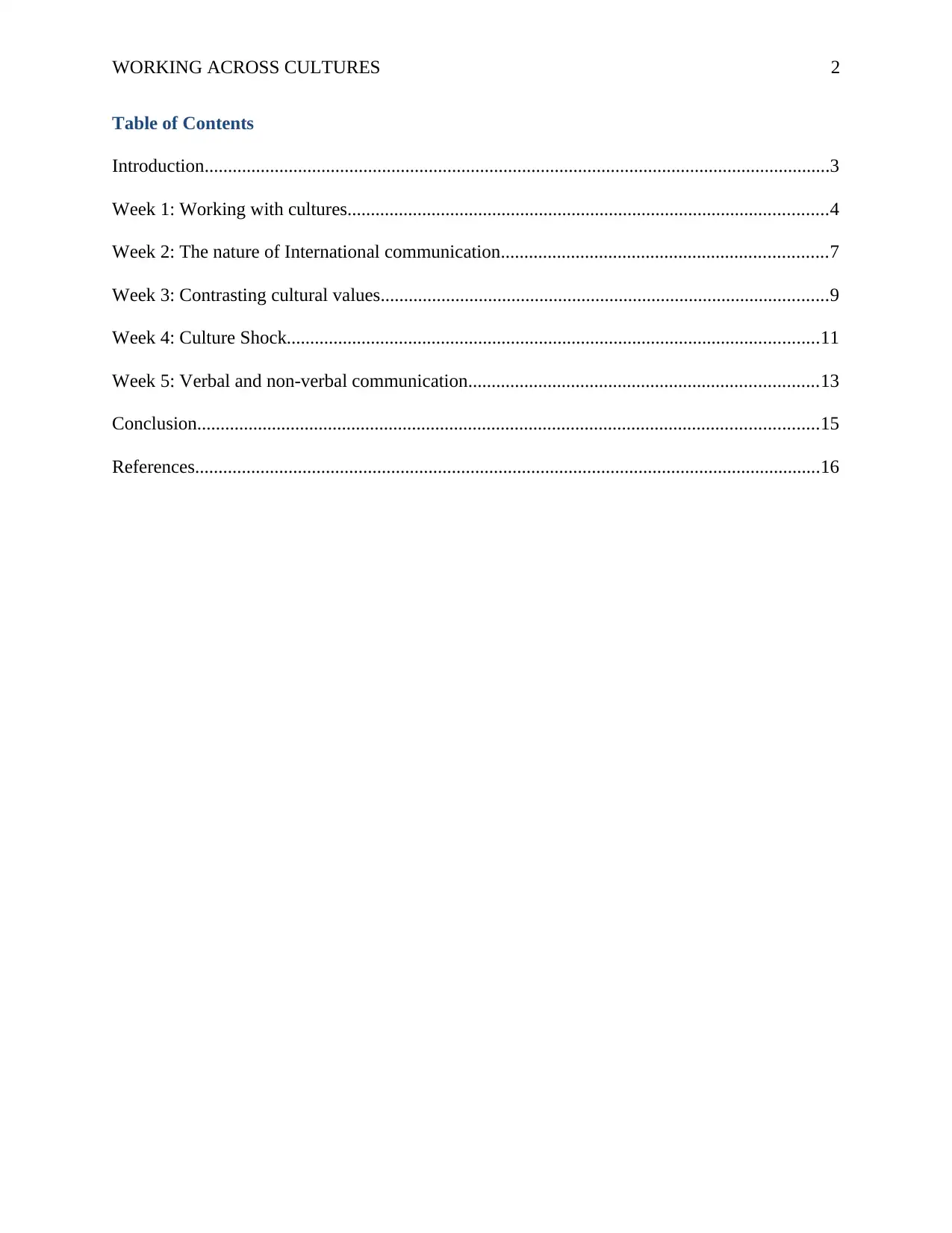
WORKING ACROSS CULTURES 2
Table of Contents
Introduction......................................................................................................................................3
Week 1: Working with cultures.......................................................................................................4
Week 2: The nature of International communication......................................................................7
Week 3: Contrasting cultural values................................................................................................9
Week 4: Culture Shock..................................................................................................................11
Week 5: Verbal and non-verbal communication...........................................................................13
Conclusion.....................................................................................................................................15
References......................................................................................................................................16
Table of Contents
Introduction......................................................................................................................................3
Week 1: Working with cultures.......................................................................................................4
Week 2: The nature of International communication......................................................................7
Week 3: Contrasting cultural values................................................................................................9
Week 4: Culture Shock..................................................................................................................11
Week 5: Verbal and non-verbal communication...........................................................................13
Conclusion.....................................................................................................................................15
References......................................................................................................................................16
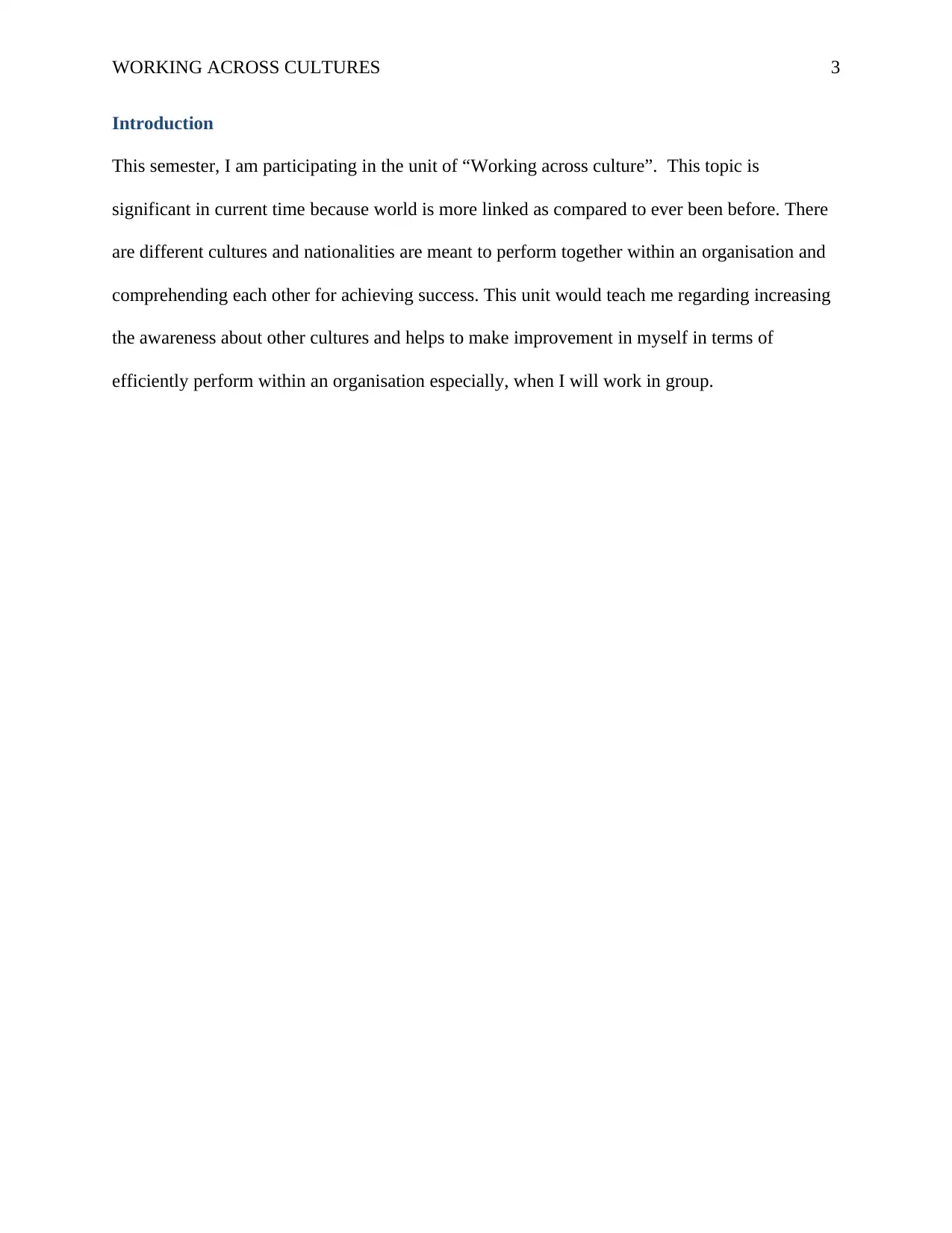
WORKING ACROSS CULTURES 3
Introduction
This semester, I am participating in the unit of “Working across culture”. This topic is
significant in current time because world is more linked as compared to ever been before. There
are different cultures and nationalities are meant to perform together within an organisation and
comprehending each other for achieving success. This unit would teach me regarding increasing
the awareness about other cultures and helps to make improvement in myself in terms of
efficiently perform within an organisation especially, when I will work in group.
Introduction
This semester, I am participating in the unit of “Working across culture”. This topic is
significant in current time because world is more linked as compared to ever been before. There
are different cultures and nationalities are meant to perform together within an organisation and
comprehending each other for achieving success. This unit would teach me regarding increasing
the awareness about other cultures and helps to make improvement in myself in terms of
efficiently perform within an organisation especially, when I will work in group.
⊘ This is a preview!⊘
Do you want full access?
Subscribe today to unlock all pages.

Trusted by 1+ million students worldwide

WORKING ACROSS CULTURES 4
Week 1: Working with cultures
During week 1, I have learned about different aspects that is asked in interview for working in
across culture such as where are you from and where did you grow up, have you visited areas
outside of Australia and where, why are taking this class, would you like to live in another
nation, where and why. Another question is who am I or from Cape Town. This week was also
beneficial for me to understand 11 official languages of South Africa such as English, Afrikaans,
Ndebele, North-Sotho, Sotho, Swazi, Zulu, Xhosa, Venda, Tsonga as well as, Tswana (Parfitt,
2018). I have learned that for education projects, there is a need to develop a new master degree
in System engineering.
I find interesting points regarding six imperative of intercultural communication such as
technological, demographic, economic, peace, self-awareness, and ethical. I find interesting to
gain depth learning regarding technological imperative. In such a manner, I have observed that
communications technology brings news as well as, information to even the remote parts of the
globe (Alexander, et. al. 2016).
Throughout this week, the key thing that puzzling, unexpected and difficult for me was to work
in a team and communicate with my team members. It was observed by me there is dividing
between those that do have access through the internet and those that do not. I have pointed out
that inequality exists between two segments (Sawrikar, 2016). Before attending a week, I have a
lack of understanding regarding different aspects, but after that, I have developed my knowledge
regarding demographic imperative. Hence, it was unexpected to me that this week would help to
improve my skills and capabilities.
From my experience, I have learned that people are practicing social media for obtaining their
news; connect across the countries and borders, to interact about their message as well as, to
Week 1: Working with cultures
During week 1, I have learned about different aspects that is asked in interview for working in
across culture such as where are you from and where did you grow up, have you visited areas
outside of Australia and where, why are taking this class, would you like to live in another
nation, where and why. Another question is who am I or from Cape Town. This week was also
beneficial for me to understand 11 official languages of South Africa such as English, Afrikaans,
Ndebele, North-Sotho, Sotho, Swazi, Zulu, Xhosa, Venda, Tsonga as well as, Tswana (Parfitt,
2018). I have learned that for education projects, there is a need to develop a new master degree
in System engineering.
I find interesting points regarding six imperative of intercultural communication such as
technological, demographic, economic, peace, self-awareness, and ethical. I find interesting to
gain depth learning regarding technological imperative. In such a manner, I have observed that
communications technology brings news as well as, information to even the remote parts of the
globe (Alexander, et. al. 2016).
Throughout this week, the key thing that puzzling, unexpected and difficult for me was to work
in a team and communicate with my team members. It was observed by me there is dividing
between those that do have access through the internet and those that do not. I have pointed out
that inequality exists between two segments (Sawrikar, 2016). Before attending a week, I have a
lack of understanding regarding different aspects, but after that, I have developed my knowledge
regarding demographic imperative. Hence, it was unexpected to me that this week would help to
improve my skills and capabilities.
From my experience, I have learned that people are practicing social media for obtaining their
news; connect across the countries and borders, to interact about their message as well as, to
Paraphrase This Document
Need a fresh take? Get an instant paraphrase of this document with our AI Paraphraser

WORKING ACROSS CULTURES 5
inspire to come together. But, I have also pointed out that using social media could be negative
in case, company unable to respond on time. I learned from my experience in teamwork and
communication skills (Douglas, Rose, & McCormack, 2016). The negative experience this week
was that sometimes, I show anger in my team. I do believe this is happening due to my
personality. But, during this week, I have learned the ways of controlling the anger.
I need to know about the challenges faced by an individual during working in across culture. I
also need to understand that modern economies are gradually more linked to those of other
nations. Furthermore, I need to know that companies should diversify their staffs for capitalizing
on richness of differences in culture (Søndergaard, & Sackmann, 2015).
I need to understand the economic benefits of culturally diverse. I can turn the situation around
using what I now know by applying my learning into my career. I would also implement
different cross-cultural imperatives in working across culture. It would be beneficial for me to
enhance my professional career. I have developed my theoretical knowledge regarding cross-
cultural imperative and it would be applied by me in a particular situation for effectively perform
within an organization (Binder, 2016). In this way, I have learned that peace imperative could be
applied by me for comprehending the different ages, sexes, ages, ethnicities, languages and
cultural backgrounds co-exist peacefully on the planet.
After attending this week, my assumptions and perspective about intercultural communication
were changed as a result of this experience. For example, I learned that intercultural experiences
teach us regarding how we react as well as, interact within a cultural context. I have also gained
my experience that intercultural communication is supportive for assessing the situations as well
as, deals with the uncertainty (Steers, & Osland, 2019). I would apply my learning in my life and
inspire to come together. But, I have also pointed out that using social media could be negative
in case, company unable to respond on time. I learned from my experience in teamwork and
communication skills (Douglas, Rose, & McCormack, 2016). The negative experience this week
was that sometimes, I show anger in my team. I do believe this is happening due to my
personality. But, during this week, I have learned the ways of controlling the anger.
I need to know about the challenges faced by an individual during working in across culture. I
also need to understand that modern economies are gradually more linked to those of other
nations. Furthermore, I need to know that companies should diversify their staffs for capitalizing
on richness of differences in culture (Søndergaard, & Sackmann, 2015).
I need to understand the economic benefits of culturally diverse. I can turn the situation around
using what I now know by applying my learning into my career. I would also implement
different cross-cultural imperatives in working across culture. It would be beneficial for me to
enhance my professional career. I have developed my theoretical knowledge regarding cross-
cultural imperative and it would be applied by me in a particular situation for effectively perform
within an organization (Binder, 2016). In this way, I have learned that peace imperative could be
applied by me for comprehending the different ages, sexes, ages, ethnicities, languages and
cultural backgrounds co-exist peacefully on the planet.
After attending this week, my assumptions and perspective about intercultural communication
were changed as a result of this experience. For example, I learned that intercultural experiences
teach us regarding how we react as well as, interact within a cultural context. I have also gained
my experience that intercultural communication is supportive for assessing the situations as well
as, deals with the uncertainty (Steers, & Osland, 2019). I would apply my learning in my life and
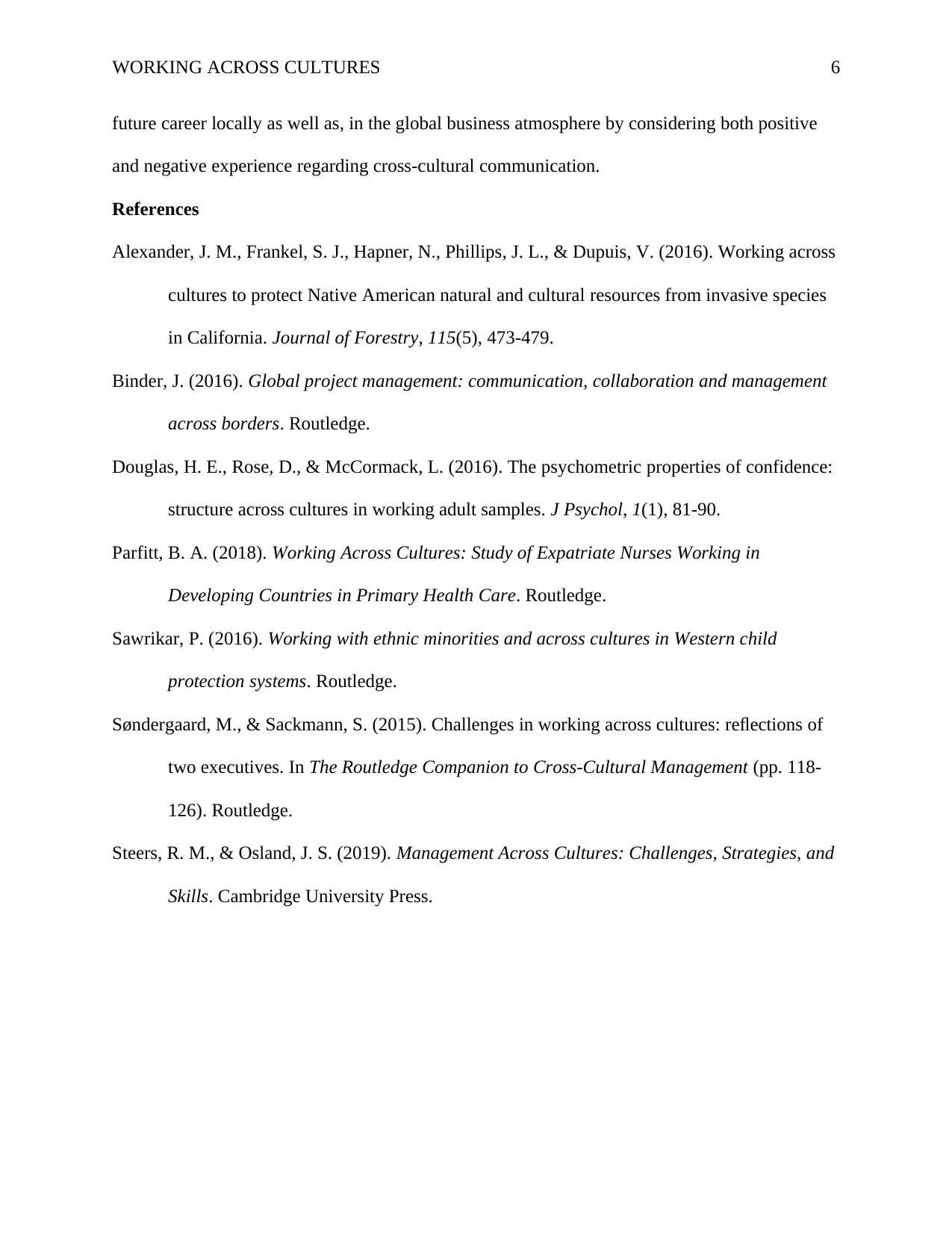
WORKING ACROSS CULTURES 6
future career locally as well as, in the global business atmosphere by considering both positive
and negative experience regarding cross-cultural communication.
References
Alexander, J. M., Frankel, S. J., Hapner, N., Phillips, J. L., & Dupuis, V. (2016). Working across
cultures to protect Native American natural and cultural resources from invasive species
in California. Journal of Forestry, 115(5), 473-479.
Binder, J. (2016). Global project management: communication, collaboration and management
across borders. Routledge.
Douglas, H. E., Rose, D., & McCormack, L. (2016). The psychometric properties of confidence:
structure across cultures in working adult samples. J Psychol, 1(1), 81-90.
Parfitt, B. A. (2018). Working Across Cultures: Study of Expatriate Nurses Working in
Developing Countries in Primary Health Care. Routledge.
Sawrikar, P. (2016). Working with ethnic minorities and across cultures in Western child
protection systems. Routledge.
Søndergaard, M., & Sackmann, S. (2015). Challenges in working across cultures: reflections of
two executives. In The Routledge Companion to Cross-Cultural Management (pp. 118-
126). Routledge.
Steers, R. M., & Osland, J. S. (2019). Management Across Cultures: Challenges, Strategies, and
Skills. Cambridge University Press.
future career locally as well as, in the global business atmosphere by considering both positive
and negative experience regarding cross-cultural communication.
References
Alexander, J. M., Frankel, S. J., Hapner, N., Phillips, J. L., & Dupuis, V. (2016). Working across
cultures to protect Native American natural and cultural resources from invasive species
in California. Journal of Forestry, 115(5), 473-479.
Binder, J. (2016). Global project management: communication, collaboration and management
across borders. Routledge.
Douglas, H. E., Rose, D., & McCormack, L. (2016). The psychometric properties of confidence:
structure across cultures in working adult samples. J Psychol, 1(1), 81-90.
Parfitt, B. A. (2018). Working Across Cultures: Study of Expatriate Nurses Working in
Developing Countries in Primary Health Care. Routledge.
Sawrikar, P. (2016). Working with ethnic minorities and across cultures in Western child
protection systems. Routledge.
Søndergaard, M., & Sackmann, S. (2015). Challenges in working across cultures: reflections of
two executives. In The Routledge Companion to Cross-Cultural Management (pp. 118-
126). Routledge.
Steers, R. M., & Osland, J. S. (2019). Management Across Cultures: Challenges, Strategies, and
Skills. Cambridge University Press.
⊘ This is a preview!⊘
Do you want full access?
Subscribe today to unlock all pages.

Trusted by 1+ million students worldwide
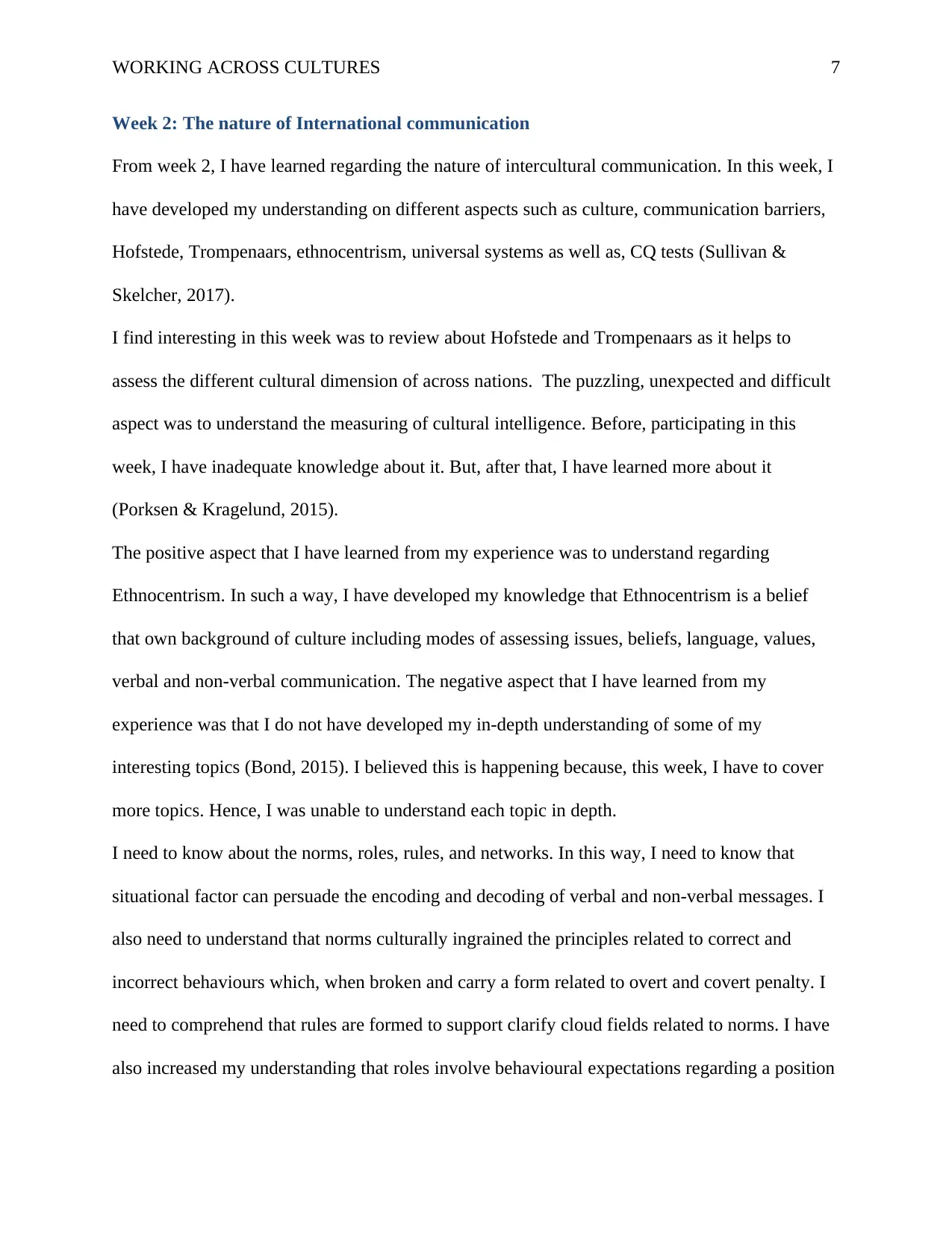
WORKING ACROSS CULTURES 7
Week 2: The nature of International communication
From week 2, I have learned regarding the nature of intercultural communication. In this week, I
have developed my understanding on different aspects such as culture, communication barriers,
Hofstede, Trompenaars, ethnocentrism, universal systems as well as, CQ tests (Sullivan &
Skelcher, 2017).
I find interesting in this week was to review about Hofstede and Trompenaars as it helps to
assess the different cultural dimension of across nations. The puzzling, unexpected and difficult
aspect was to understand the measuring of cultural intelligence. Before, participating in this
week, I have inadequate knowledge about it. But, after that, I have learned more about it
(Porksen & Kragelund, 2015).
The positive aspect that I have learned from my experience was to understand regarding
Ethnocentrism. In such a way, I have developed my knowledge that Ethnocentrism is a belief
that own background of culture including modes of assessing issues, beliefs, language, values,
verbal and non-verbal communication. The negative aspect that I have learned from my
experience was that I do not have developed my in-depth understanding of some of my
interesting topics (Bond, 2015). I believed this is happening because, this week, I have to cover
more topics. Hence, I was unable to understand each topic in depth.
I need to know about the norms, roles, rules, and networks. In this way, I need to know that
situational factor can persuade the encoding and decoding of verbal and non-verbal messages. I
also need to understand that norms culturally ingrained the principles related to correct and
incorrect behaviours which, when broken and carry a form related to overt and covert penalty. I
need to comprehend that rules are formed to support clarify cloud fields related to norms. I have
also increased my understanding that roles involve behavioural expectations regarding a position
Week 2: The nature of International communication
From week 2, I have learned regarding the nature of intercultural communication. In this week, I
have developed my understanding on different aspects such as culture, communication barriers,
Hofstede, Trompenaars, ethnocentrism, universal systems as well as, CQ tests (Sullivan &
Skelcher, 2017).
I find interesting in this week was to review about Hofstede and Trompenaars as it helps to
assess the different cultural dimension of across nations. The puzzling, unexpected and difficult
aspect was to understand the measuring of cultural intelligence. Before, participating in this
week, I have inadequate knowledge about it. But, after that, I have learned more about it
(Porksen & Kragelund, 2015).
The positive aspect that I have learned from my experience was to understand regarding
Ethnocentrism. In such a way, I have developed my knowledge that Ethnocentrism is a belief
that own background of culture including modes of assessing issues, beliefs, language, values,
verbal and non-verbal communication. The negative aspect that I have learned from my
experience was that I do not have developed my in-depth understanding of some of my
interesting topics (Bond, 2015). I believed this is happening because, this week, I have to cover
more topics. Hence, I was unable to understand each topic in depth.
I need to know about the norms, roles, rules, and networks. In this way, I need to know that
situational factor can persuade the encoding and decoding of verbal and non-verbal messages. I
also need to understand that norms culturally ingrained the principles related to correct and
incorrect behaviours which, when broken and carry a form related to overt and covert penalty. I
need to comprehend that rules are formed to support clarify cloud fields related to norms. I have
also increased my understanding that roles involve behavioural expectations regarding a position
Paraphrase This Document
Need a fresh take? Get an instant paraphrase of this document with our AI Paraphraser

WORKING ACROSS CULTURES 8
within the culture and these expectations are influenced by norms as well as, rules (Flynn,
Castellanos, & Flores-Andrade, 2018).
I can turn the situation around using I now know by considering the communication barriers.
These barriers are physical, cultural, perception, and motivational. Other cultural barriers are
emotional, linguistic and competition barriers. I can apply my theoretical knowledge regarding
culture to a particular situation like working in across the culture and it would be also used by me
to communicate with the diverse culture of people. My assumptions and perspectives have
changed as a result of this experience. Because, before attending this week, I have a lack of
knowledge regarding this aspect (Ting-Toomey & Dorjee, 2018). I would apply my learning to
my life and future career locally and in the global business environment.
References
Bond, M. H. (2015). Working at the interface of cultures: Eighteen lives in social science.
Routledge.
Flynn, M. A., Castellanos, E., & Flores-Andrade, A. (2018). Safety across cultures:
Understanding the challenges. Professional Safety, 63(01), 28-32.
Porksen, N., & Kragelund, L. (2015). Challenges in working across cultures. The Routledge
Companion to Cross-Cultural Management, 68.
Sullivan, H., & Skelcher, C. (2017). Working across boundaries: collaboration in public
services. Macmillan International Higher Education.
Ting-Toomey, S., & Dorjee, T. (2018). Communicating across cultures. Guilford Publications.
within the culture and these expectations are influenced by norms as well as, rules (Flynn,
Castellanos, & Flores-Andrade, 2018).
I can turn the situation around using I now know by considering the communication barriers.
These barriers are physical, cultural, perception, and motivational. Other cultural barriers are
emotional, linguistic and competition barriers. I can apply my theoretical knowledge regarding
culture to a particular situation like working in across the culture and it would be also used by me
to communicate with the diverse culture of people. My assumptions and perspectives have
changed as a result of this experience. Because, before attending this week, I have a lack of
knowledge regarding this aspect (Ting-Toomey & Dorjee, 2018). I would apply my learning to
my life and future career locally and in the global business environment.
References
Bond, M. H. (2015). Working at the interface of cultures: Eighteen lives in social science.
Routledge.
Flynn, M. A., Castellanos, E., & Flores-Andrade, A. (2018). Safety across cultures:
Understanding the challenges. Professional Safety, 63(01), 28-32.
Porksen, N., & Kragelund, L. (2015). Challenges in working across cultures. The Routledge
Companion to Cross-Cultural Management, 68.
Sullivan, H., & Skelcher, C. (2017). Working across boundaries: collaboration in public
services. Macmillan International Higher Education.
Ting-Toomey, S., & Dorjee, T. (2018). Communicating across cultures. Guilford Publications.
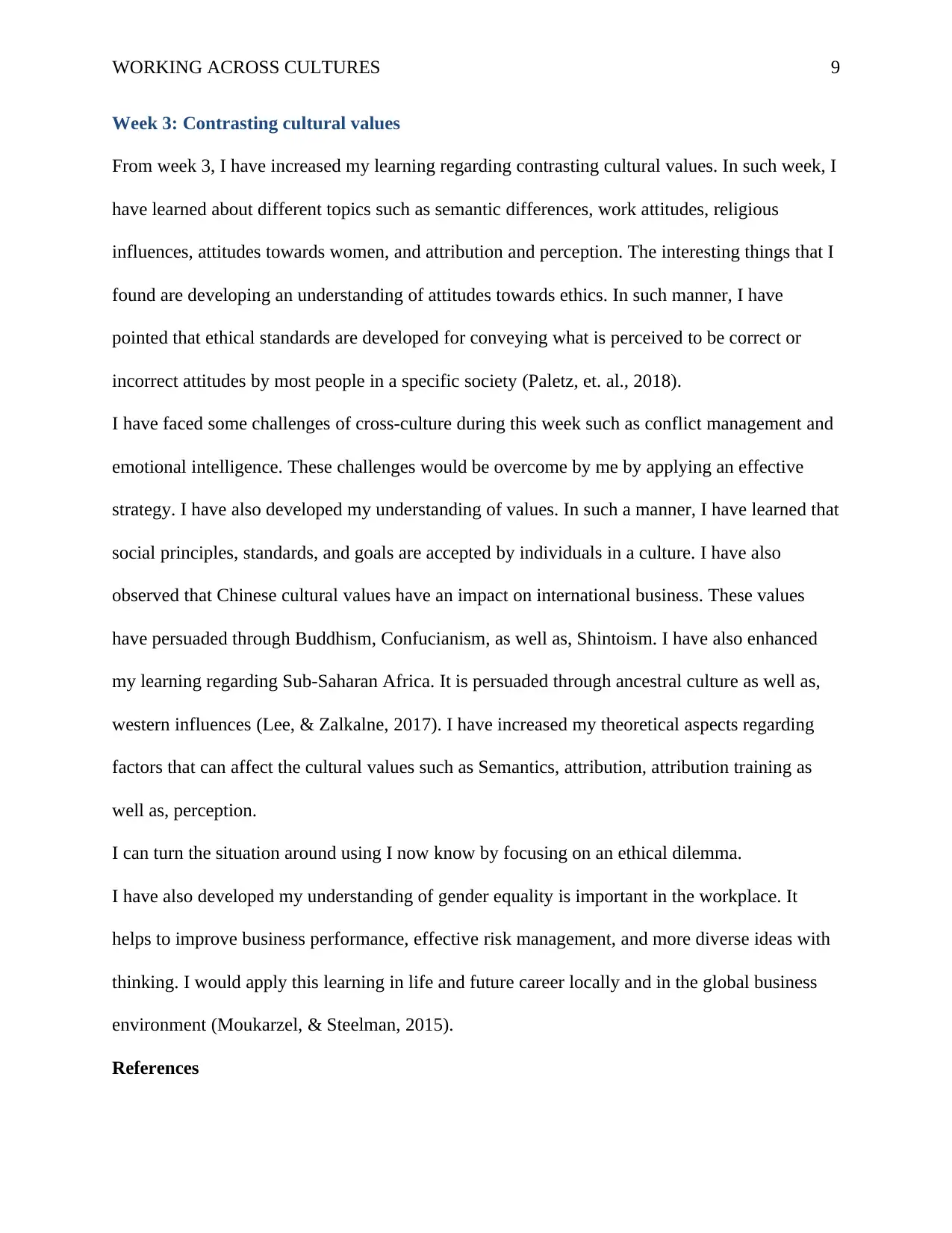
WORKING ACROSS CULTURES 9
Week 3: Contrasting cultural values
From week 3, I have increased my learning regarding contrasting cultural values. In such week, I
have learned about different topics such as semantic differences, work attitudes, religious
influences, attitudes towards women, and attribution and perception. The interesting things that I
found are developing an understanding of attitudes towards ethics. In such manner, I have
pointed that ethical standards are developed for conveying what is perceived to be correct or
incorrect attitudes by most people in a specific society (Paletz, et. al., 2018).
I have faced some challenges of cross-culture during this week such as conflict management and
emotional intelligence. These challenges would be overcome by me by applying an effective
strategy. I have also developed my understanding of values. In such a manner, I have learned that
social principles, standards, and goals are accepted by individuals in a culture. I have also
observed that Chinese cultural values have an impact on international business. These values
have persuaded through Buddhism, Confucianism, as well as, Shintoism. I have also enhanced
my learning regarding Sub-Saharan Africa. It is persuaded through ancestral culture as well as,
western influences (Lee, & Zalkalne, 2017). I have increased my theoretical aspects regarding
factors that can affect the cultural values such as Semantics, attribution, attribution training as
well as, perception.
I can turn the situation around using I now know by focusing on an ethical dilemma.
I have also developed my understanding of gender equality is important in the workplace. It
helps to improve business performance, effective risk management, and more diverse ideas with
thinking. I would apply this learning in life and future career locally and in the global business
environment (Moukarzel, & Steelman, 2015).
References
Week 3: Contrasting cultural values
From week 3, I have increased my learning regarding contrasting cultural values. In such week, I
have learned about different topics such as semantic differences, work attitudes, religious
influences, attitudes towards women, and attribution and perception. The interesting things that I
found are developing an understanding of attitudes towards ethics. In such manner, I have
pointed that ethical standards are developed for conveying what is perceived to be correct or
incorrect attitudes by most people in a specific society (Paletz, et. al., 2018).
I have faced some challenges of cross-culture during this week such as conflict management and
emotional intelligence. These challenges would be overcome by me by applying an effective
strategy. I have also developed my understanding of values. In such a manner, I have learned that
social principles, standards, and goals are accepted by individuals in a culture. I have also
observed that Chinese cultural values have an impact on international business. These values
have persuaded through Buddhism, Confucianism, as well as, Shintoism. I have also enhanced
my learning regarding Sub-Saharan Africa. It is persuaded through ancestral culture as well as,
western influences (Lee, & Zalkalne, 2017). I have increased my theoretical aspects regarding
factors that can affect the cultural values such as Semantics, attribution, attribution training as
well as, perception.
I can turn the situation around using I now know by focusing on an ethical dilemma.
I have also developed my understanding of gender equality is important in the workplace. It
helps to improve business performance, effective risk management, and more diverse ideas with
thinking. I would apply this learning in life and future career locally and in the global business
environment (Moukarzel, & Steelman, 2015).
References
⊘ This is a preview!⊘
Do you want full access?
Subscribe today to unlock all pages.

Trusted by 1+ million students worldwide

WORKING ACROSS CULTURES 10
Lee, C. C., & Zalkalne, E. (2017). Counseling Across Cultures. In Introduction to the Counseling
Profession (pp. 54-72). Routledge.
Moukarzel, R., & Steelman, L. A. (2015). Navigating multicultural teams: a road map to
feedback across cultures. In Leading global teams (pp. 169-192). Springer, New York,
NY.
Paletz, S. B., Pavisic, I., Miron-Spektor, E., Lin, C. C., Paletz, S. B. F., Pavisic, I., ... & Lin, C.
C. (2018). Diversity in creative teams: Reaching across cultures and
disciplines. Handbook of culture and creativity: Basic processes and applied innovations,
169-206.
Lee, C. C., & Zalkalne, E. (2017). Counseling Across Cultures. In Introduction to the Counseling
Profession (pp. 54-72). Routledge.
Moukarzel, R., & Steelman, L. A. (2015). Navigating multicultural teams: a road map to
feedback across cultures. In Leading global teams (pp. 169-192). Springer, New York,
NY.
Paletz, S. B., Pavisic, I., Miron-Spektor, E., Lin, C. C., Paletz, S. B. F., Pavisic, I., ... & Lin, C.
C. (2018). Diversity in creative teams: Reaching across cultures and
disciplines. Handbook of culture and creativity: Basic processes and applied innovations,
169-206.
Paraphrase This Document
Need a fresh take? Get an instant paraphrase of this document with our AI Paraphraser
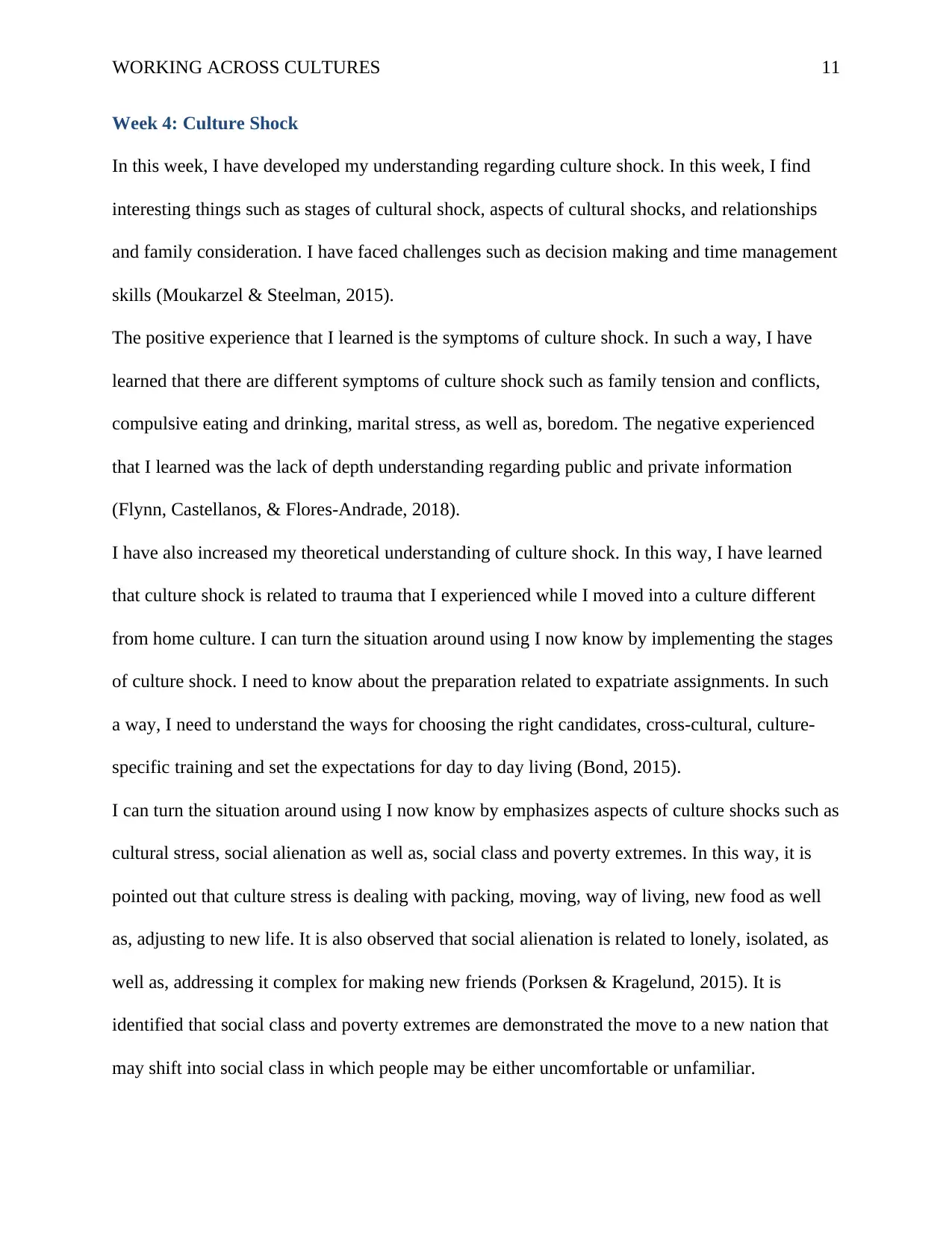
WORKING ACROSS CULTURES 11
Week 4: Culture Shock
In this week, I have developed my understanding regarding culture shock. In this week, I find
interesting things such as stages of cultural shock, aspects of cultural shocks, and relationships
and family consideration. I have faced challenges such as decision making and time management
skills (Moukarzel & Steelman, 2015).
The positive experience that I learned is the symptoms of culture shock. In such a way, I have
learned that there are different symptoms of culture shock such as family tension and conflicts,
compulsive eating and drinking, marital stress, as well as, boredom. The negative experienced
that I learned was the lack of depth understanding regarding public and private information
(Flynn, Castellanos, & Flores-Andrade, 2018).
I have also increased my theoretical understanding of culture shock. In this way, I have learned
that culture shock is related to trauma that I experienced while I moved into a culture different
from home culture. I can turn the situation around using I now know by implementing the stages
of culture shock. I need to know about the preparation related to expatriate assignments. In such
a way, I need to understand the ways for choosing the right candidates, cross-cultural, culture-
specific training and set the expectations for day to day living (Bond, 2015).
I can turn the situation around using I now know by emphasizes aspects of culture shocks such as
cultural stress, social alienation as well as, social class and poverty extremes. In this way, it is
pointed out that culture stress is dealing with packing, moving, way of living, new food as well
as, adjusting to new life. It is also observed that social alienation is related to lonely, isolated, as
well as, addressing it complex for making new friends (Porksen & Kragelund, 2015). It is
identified that social class and poverty extremes are demonstrated the move to a new nation that
may shift into social class in which people may be either uncomfortable or unfamiliar.
Week 4: Culture Shock
In this week, I have developed my understanding regarding culture shock. In this week, I find
interesting things such as stages of cultural shock, aspects of cultural shocks, and relationships
and family consideration. I have faced challenges such as decision making and time management
skills (Moukarzel & Steelman, 2015).
The positive experience that I learned is the symptoms of culture shock. In such a way, I have
learned that there are different symptoms of culture shock such as family tension and conflicts,
compulsive eating and drinking, marital stress, as well as, boredom. The negative experienced
that I learned was the lack of depth understanding regarding public and private information
(Flynn, Castellanos, & Flores-Andrade, 2018).
I have also increased my theoretical understanding of culture shock. In this way, I have learned
that culture shock is related to trauma that I experienced while I moved into a culture different
from home culture. I can turn the situation around using I now know by implementing the stages
of culture shock. I need to know about the preparation related to expatriate assignments. In such
a way, I need to understand the ways for choosing the right candidates, cross-cultural, culture-
specific training and set the expectations for day to day living (Bond, 2015).
I can turn the situation around using I now know by emphasizes aspects of culture shocks such as
cultural stress, social alienation as well as, social class and poverty extremes. In this way, it is
pointed out that culture stress is dealing with packing, moving, way of living, new food as well
as, adjusting to new life. It is also observed that social alienation is related to lonely, isolated, as
well as, addressing it complex for making new friends (Porksen & Kragelund, 2015). It is
identified that social class and poverty extremes are demonstrated the move to a new nation that
may shift into social class in which people may be either uncomfortable or unfamiliar.

WORKING ACROSS CULTURES 12
I have developed my understanding regarding Asia Shock for travelers from the USA. These are
frustration with the culture, unwillingness to comprehend, racism, ethnocentricity as well as,
avoidance of culture. These understanding would be applied by me in my personal and
professional career (Sullivan & Skelcher, 2017).
I have generated my theoretical understanding regarding Johari Window. In such a way, I have
learned that people in different cultures differ in terms of how much of the inner self is shared
with others. There are four arenas in Johari window such as Arena, Blindspot, hidden as well as,
unknown. I would apply this learning in life and future career locally and in the global business
environment (Steers & Osland, 2019).
References
Bond, M. H. (2015). Working at the interface of cultures: Eighteen lives in social science.
Routledge.
Flynn, M. A., Castellanos, E., & Flores-Andrade, A. (2018). Safety across cultures:
Understanding the challenges. Professional Safety, 63(01), 28-32.
Moukarzel, R., & Steelman, L. A. (2015). Navigating multicultural teams: a road map to
feedback across cultures. In Leading global teams (pp. 169-192). Springer, New York,
NY.
Porksen, N., & Kragelund, L. (2015). Challenges in working across cultures. The Routledge
Companion to Cross-Cultural Management, 68.
Steers, R. M., & Osland, J. S. (2019). Management Across Cultures: Challenges, Strategies, and
Skills. Cambridge University Press.
Sullivan, H., & Skelcher, C. (2017). Working across boundaries: collaboration in public
services. Macmillan International Higher Education.
I have developed my understanding regarding Asia Shock for travelers from the USA. These are
frustration with the culture, unwillingness to comprehend, racism, ethnocentricity as well as,
avoidance of culture. These understanding would be applied by me in my personal and
professional career (Sullivan & Skelcher, 2017).
I have generated my theoretical understanding regarding Johari Window. In such a way, I have
learned that people in different cultures differ in terms of how much of the inner self is shared
with others. There are four arenas in Johari window such as Arena, Blindspot, hidden as well as,
unknown. I would apply this learning in life and future career locally and in the global business
environment (Steers & Osland, 2019).
References
Bond, M. H. (2015). Working at the interface of cultures: Eighteen lives in social science.
Routledge.
Flynn, M. A., Castellanos, E., & Flores-Andrade, A. (2018). Safety across cultures:
Understanding the challenges. Professional Safety, 63(01), 28-32.
Moukarzel, R., & Steelman, L. A. (2015). Navigating multicultural teams: a road map to
feedback across cultures. In Leading global teams (pp. 169-192). Springer, New York,
NY.
Porksen, N., & Kragelund, L. (2015). Challenges in working across cultures. The Routledge
Companion to Cross-Cultural Management, 68.
Steers, R. M., & Osland, J. S. (2019). Management Across Cultures: Challenges, Strategies, and
Skills. Cambridge University Press.
Sullivan, H., & Skelcher, C. (2017). Working across boundaries: collaboration in public
services. Macmillan International Higher Education.
⊘ This is a preview!⊘
Do you want full access?
Subscribe today to unlock all pages.

Trusted by 1+ million students worldwide
1 out of 17
Related Documents
Your All-in-One AI-Powered Toolkit for Academic Success.
+13062052269
info@desklib.com
Available 24*7 on WhatsApp / Email
![[object Object]](/_next/static/media/star-bottom.7253800d.svg)
Unlock your academic potential
Copyright © 2020–2025 A2Z Services. All Rights Reserved. Developed and managed by ZUCOL.





